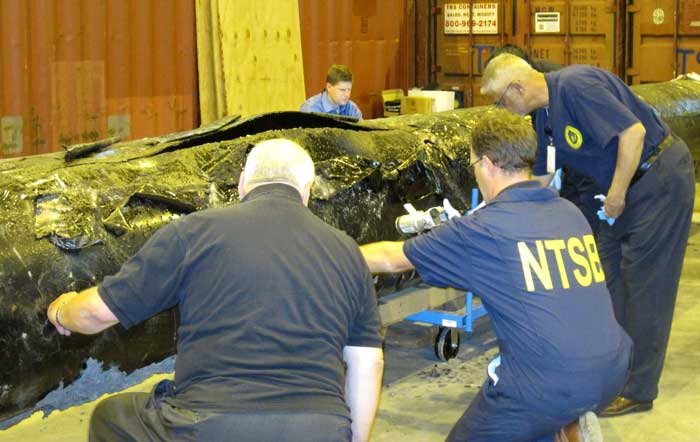 In their filing with the Joint Review Panel, the Haisla Nation point to what they say is inadequate information provided by Enbridge on the Northern Gateway project, including:
In their filing with the Joint Review Panel, the Haisla Nation point to what they say is inadequate information provided by Enbridge on the Northern Gateway project, including:
To date the material provided by Northern Gateway does not adequately explain the known risks inherent to the proposed project and lacks significant detail with respect to the extent and degree of potential effects. The material provided by Northern Gateway does not provide sufficient information to determine how the risks inherent to the proposed project will be minimized, nor how the potential for significant adverse effects will be avoided.
There are a number of areas where the Haisla Nation has identified inadequateinformation, including but not limited to:
.
Design: there is a lack of information about detailed design considerations and monitoring procedures for pipeline integrity to avoid accidents and malfunctions due to corrosion, seismic events, and terrain instability. A notable example of this problem is in the Kitimat River Valley, where Northern Gateway has identified a high level of risk but has not offered any solutions. Another is the concern about the corrosive nature of the material to be transported. Northern Gateway denies that this is a problem, yet the US Department of Transportation Pipeline and
Hazardous Material Safety Administration (PHMSA) has commissioned a major study to investigate the corrosive nature of diluted bitumen in pipelines.Materials to be transported: there is a lack of information about the fate, behaviour and effects of diluted bitumen, synthetic crude and condensate in the cold water marine and freshwater environment. This concern has been identified by federal government participants as well as by numerous intervenors, and Northern Gateway has acknowledged the need for more research and information. Yet, Northern Gateway has not agreed to undertake this work so that it is available for review in this process.
Volume of material to be transported: Northern Gateway’s application is for a pipeline that will transport 525,000 barrels of diluted bitumen per day. Yet the pipeline will be built to have a capacity of up to 850,000 barrels per day, and Northern Gateway’s application materials identifies future phases with increased volumes up to this amount. The risk assessments conducted by Northern Gateway are premised on 525,000 barrels per day, and fail to contemplate higher volumes which would affect a number of matters, including but not limited to: pipeline risk; volume of potential spills; and tanker traffic volume. The risk assessment needs to be revised, to address the risks associated with the pipeline transporting 850,000 barrels of diluted bitumen per day. Without this revision, Northern Gateway is asking the JRP to conduct its assessment on incomplete information that, by definition, understates the true potential risk of the proposed project.
.Baseline information: Northern Gateway has not undertaken the studies necessary to generate baseline ecosystem assessments for the Kitimat River drainage and Kitimat Arm, including seasonal habitat utilization by species and life stages throughout the watershed. This information is necessary to determine both stream crossing construction strategy and to assess the potential impacts of a spill, as well as to determine how to respond to a spill and when. A ‘one-size fits all’ approach to stream crossings during construction and spill response, when adequateinformation about seasonal habitat utilization by species and life stages throughout the watershed is lacking, is not adequate. This information is needed to determine when construction can proceed and what timeframe limitations there are for activities, to ensure that adverse effects to fish and wildlife are avoided. This information is also required, should a spill occur, to enable a proper assessment of the extent and degree of adverse effects as well as to provide a proper basis for restoration of affected habitat.
Past spills: there is a lack of information about the cause, effects, emerging information and lessons learned as a result of Enbridge’s large diluted bitumen spill into the Kalamazoo River. We know that 3,785,400 liters of diluted bitumen were pumped out of the pipeline, with a largeportion of that ending up in to the Kalamazoo River. We know the large volume of the spill was the result of numerous attempts to re-pressurize the pipeline despite repeated spill alarms being triggered. We know that government agencies stepped in to manage the spill because Enbridge’s response was not swift enough. We know that Enbridge’s clean-up costs to date exceed insurance coverage. We know that two years later Enbridge is still under a clean-up mandate from the US Environmental Protection Agency and the Michigan Department of Environmental Quality, and that portions of the Kalamazoo River are still closed to recreational use. What we do not know, however, is what the cause of the pipeline rupture was, what Enbridge has learned about how diluted bitumen behaves once it is released into the environment, or how a local population that relies on the river for fishing, for traditional harvesting and gathering of foods and medicines would have been affected.
Oil spill response: there is a lack of information about oil spill response and planning, including best practices, best available technology and the local on-site equipment and personnel required full-time to respond properly to a spill. This is largely due to the lack of adequate baseline information on which to base response planning. Further, Northern Gateway has demonstrated an unwillingness to fully consider how spill response would be carried out until it receives a certificate for its project.
Yet Northern Gateway seeks to rely on spill response as a mitigation strategy. If Northern Gateway seeks to rely on spill response as a mitigation strategy, it should provide in detail, prior to project approval, what its oil spill response would include and demonstrate that it is logistically, technologically and economically feasible. Northern Gateway has not done this.
.Mitigation measures: there is a lack of information about existing proven mitigation measures and their effectiveness in cleaning up an oil spill, restoring habitat and regenerating the species dependent on the affected habitat. This should be evaluated as part of project review, prior to project approval. Where Northern Gateway seeks to rely on a mitigation measure as a basis for project approval, it must demonstrate that the proposed mitigation will actually work.
Avoidance of any significant adverse effects must be the primary goal and dictate the design and location of the proposed project. Mitigation (e.g. complete resolution) of any potential environmental effects should be the preferred option, when all efforts to avoid such effects fail. Compensation for environmental effects must be a last resort and relied on only when best efforts have been made to avoid or mitigate effects. Unfortunately, the material submitted by Northern Gateway suggests that compensation is the primary option and lack of evidence on project design and procedures makes it impossible to evaluate how potential effects could be avoided or mitigated.
For example, Northern Gateway proposes to have spill interception points (river control points) along the Kitimat River Valley as part of its mitigation, but has no realistic plan in place that takes into consideration response delay times, rates of transportation, access issues or baseline ecosystem, fish and wildlife information for the receiving environment.
Main story Haisla Nation confirms it opposes Northern Gateway, demands Ottawa veto Enbridge pipeline; First Nation also outlines “minimum conditions” if Ottawa approves the project
Haisla Nation Response to NGP Information Request (pdf)




 A tanker entering Prince Rupert harbour. (Robin Rowland/Northwest Coast Energy News)
A tanker entering Prince Rupert harbour. (Robin Rowland/Northwest Coast Energy News) On November 16, 2011,
On November 16, 2011,  On November 17, 2011,
On November 17, 2011,  On Nov. 22,
On Nov. 22, On Nov. 23, ACM Shipping, a British company, told
On Nov. 23, ACM Shipping, a British company, told